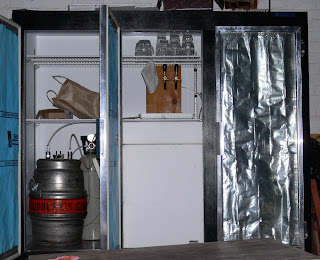reg
Well-Known Member
- Joined
- 3/1/07
- Messages
- 757
- Reaction score
- 2
Have just had a score of a commercial single door fridge that was not working.
Had a play and found the thermostat was rooted.
Anyway modified wiring and installed a fridgemate and BOBs your uncle.
Just thinking whether to use it as a fermentation fridge or for a keg set up.
If I use it for a keg set up I need to put taps in the door through the glass.
Has anyone done this or seen a set up of it being done?
Can I use a holesaw or do I need to take it to glazier?
Failing that I could replace the glass with timber but this eliminates part of the appeal of a glass door fridge.
I could fit 6 kegs in my other fridge but could fit 8 in the glass door one..
Also are commercial compressors very hardy and could I run the fridgemate setting at 3 minutes rather than 9?
Any advice wanted, any pics better..
Edit:the compressor setting on fridgemate added
Had a play and found the thermostat was rooted.
Anyway modified wiring and installed a fridgemate and BOBs your uncle.
Just thinking whether to use it as a fermentation fridge or for a keg set up.
If I use it for a keg set up I need to put taps in the door through the glass.
Has anyone done this or seen a set up of it being done?
Can I use a holesaw or do I need to take it to glazier?
Failing that I could replace the glass with timber but this eliminates part of the appeal of a glass door fridge.
I could fit 6 kegs in my other fridge but could fit 8 in the glass door one..
Also are commercial compressors very hardy and could I run the fridgemate setting at 3 minutes rather than 9?
Any advice wanted, any pics better..
Edit:the compressor setting on fridgemate added





